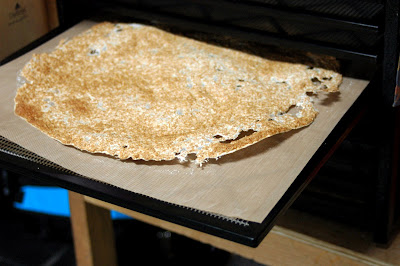Pin It
Have a great sourdough starter, but want to save some just in case it dies? Want to give some to a friend that lives a few states away? Need a long break from making sourdough or planning a long vacation this coming summer?
Dehydrating your starter is the way to go.
Having dehydrated starter will come in handy "just-in-case" your fresh starter suddenly stops working, a family member (not familiar with your healthy, fermented food collection) tosses out your lively starter thinking it was food gone bad, a friend wants to try making sourdough (dried starter less messy to ship ~wink~), everybody is growing tired of sourdough (hope that doesn't happen with us!) or you are planning a month or two away from home.
These are many good reasons to preserve your sourdough for those "just-in-case" moments!
Storing your starter in the fridge is a good, simple solution for short vacations and weekly breaks, but when you need to store your starter for longer periods... dehydrating is the best way to go.
Its easy!
If you don't have a dehydrator... don't sweat it. You can do it without one!
I did this back before we left for our 2 1/2 month trip stateside and I'm so glad I did! I made the batch of dehydrated starter, but also left a small amount of live starter in a jar in the back of the fridge.
Well, guess what we found when we got back? Yep, an explosion... cracked jar with dried/wet, moldy starter all over the back of my fridge. I thought I let it settle down enough (dormant) before tightening the lid, guess not! It was truly a pain to clean up.
But I didn't worry because I had my dried starter in the freezer. I mix it up with some water and had a thriving sourdough in 2 days! Sweet!
Dehydrating Your Starter
All you need is:
Place the parchment paper on the dehydrator tray or baking tray. Spread starter in a very thin layer on the parchment paper. You can dry your starter in one of two ways:
In room temperature. Dry your starter in a clean area, at room temperature (between 70 to 80 degrees F) until dry. When it develops a dray skin on top, cover with a light cloth to keep dust and bugs off. If temps are much lower than the 70s, mold may be an issue. If temps are much higher than the 80s, the organisms may die.
In dehydrator . Put tray in dehydrator and turn the dial so that it is just barely turned on. Dry for about 6 to 10 hours, depending on thinness of the starter. Check it often if you can.
. Put tray in dehydrator and turn the dial so that it is just barely turned on. Dry for about 6 to 10 hours, depending on thinness of the starter. Check it often if you can.
Now, when your starter is crispy dry... break into smaller pieces (you will now have "starter flakes" and transfer to a freezer bag or container. Store in freezer for up to a year (according to Sourdough A to Z eBook). We don't know for sure how long a dehydrated starter will last, but it would be best to repeat the process yearly with fresh starter.
That said, I'll most likely be dehydrating a batch of my starter every August! Better safe than sorry!
Rehydrating Your Starter
Mix together 2 hefty tablespoons of dehydrated starter flakes and 1/3 cup of water into a clean, quart size jar or medium/large glass bowl. Mix well. Allow the flakes to soften for about 5 minutes.
Add 1/3 cup of whole wheat or your choice of flour and mix vigorously. Get as much air into it as you can. Cover with a cloth towel and place in a warm area or room temp area for about 24 hours. The warmer the temperature, the quicker it will rehydrate and bubble up. Don't let the temps go beyond 85 degrees F if you can help it. The mixture may or may not be bubble after this first step, but don't stop there!
Mix in 1/2 cup water and 1/2 cup flour. Mix vigorously to get air in. Cover and return to a warm spot for 12 hours.
Repeat this process every 12 to 24 hours until the starter is light and bubbly with a nice sour smell.
Now you should have a reactivated starter!
Your starter is considered reactivated when it continues to get light and bubbly for at least 3 good feedings. In cooler areas (like mine!), it may take longer... up to several days. But I did say up there that is was thriving after 2 days and this was during a very cool & rainy time in my area. My starter must have been very strong!
Now, go get your stuff together and get some starter preserved! Better now, then have regrets later :o)
Have a great sourdough starter, but want to save some just in case it dies? Want to give some to a friend that lives a few states away? Need a long break from making sourdough or planning a long vacation this coming summer?
Dehydrating your starter is the way to go.
Having dehydrated starter will come in handy "just-in-case" your fresh starter suddenly stops working, a family member (not familiar with your healthy, fermented food collection) tosses out your lively starter thinking it was food gone bad, a friend wants to try making sourdough (dried starter less messy to ship ~wink~), everybody is growing tired of sourdough (hope that doesn't happen with us!) or you are planning a month or two away from home.
These are many good reasons to preserve your sourdough for those "just-in-case" moments!
Storing your starter in the fridge is a good, simple solution for short vacations and weekly breaks, but when you need to store your starter for longer periods... dehydrating is the best way to go.
Its easy!
If you don't have a dehydrator... don't sweat it. You can do it without one!
I did this back before we left for our 2 1/2 month trip stateside and I'm so glad I did! I made the batch of dehydrated starter, but also left a small amount of live starter in a jar in the back of the fridge.
Well, guess what we found when we got back? Yep, an explosion... cracked jar with dried/wet, moldy starter all over the back of my fridge. I thought I let it settle down enough (dormant) before tightening the lid, guess not! It was truly a pain to clean up.
But I didn't worry because I had my dried starter in the freezer. I mix it up with some water and had a thriving sourdough in 2 days! Sweet!
Dehydrating Your Starter
All you need is:
- 1/4 - 1/3 cup of mature, thriving sourdough starter, fed within the last 12 hours (Allow the starter to build up before drying it out to be at a maximum level. I dehydrated mine after I fed it and left it alone for about 5 hours)
- Parchment paper or non-stick dehydrator sheet
- Dehydrator tray or baking sheet
- Dehydrator
(optional)
Place the parchment paper on the dehydrator tray or baking tray. Spread starter in a very thin layer on the parchment paper. You can dry your starter in one of two ways:
In room temperature. Dry your starter in a clean area, at room temperature (between 70 to 80 degrees F) until dry. When it develops a dray skin on top, cover with a light cloth to keep dust and bugs off. If temps are much lower than the 70s, mold may be an issue. If temps are much higher than the 80s, the organisms may die.
In dehydrator
Now, when your starter is crispy dry... break into smaller pieces (you will now have "starter flakes" and transfer to a freezer bag or container. Store in freezer for up to a year (according to Sourdough A to Z eBook). We don't know for sure how long a dehydrated starter will last, but it would be best to repeat the process yearly with fresh starter.
That said, I'll most likely be dehydrating a batch of my starter every August! Better safe than sorry!
Rehydrating Your Starter
Mix together 2 hefty tablespoons of dehydrated starter flakes and 1/3 cup of water into a clean, quart size jar or medium/large glass bowl. Mix well. Allow the flakes to soften for about 5 minutes.
Add 1/3 cup of whole wheat or your choice of flour and mix vigorously. Get as much air into it as you can. Cover with a cloth towel and place in a warm area or room temp area for about 24 hours. The warmer the temperature, the quicker it will rehydrate and bubble up. Don't let the temps go beyond 85 degrees F if you can help it. The mixture may or may not be bubble after this first step, but don't stop there!
Mix in 1/2 cup water and 1/2 cup flour. Mix vigorously to get air in. Cover and return to a warm spot for 12 hours.
Repeat this process every 12 to 24 hours until the starter is light and bubbly with a nice sour smell.
Now you should have a reactivated starter!
Your starter is considered reactivated when it continues to get light and bubbly for at least 3 good feedings. In cooler areas (like mine!), it may take longer... up to several days. But I did say up there that is was thriving after 2 days and this was during a very cool & rainy time in my area. My starter must have been very strong!
Now, go get your stuff together and get some starter preserved! Better now, then have regrets later :o)
















































